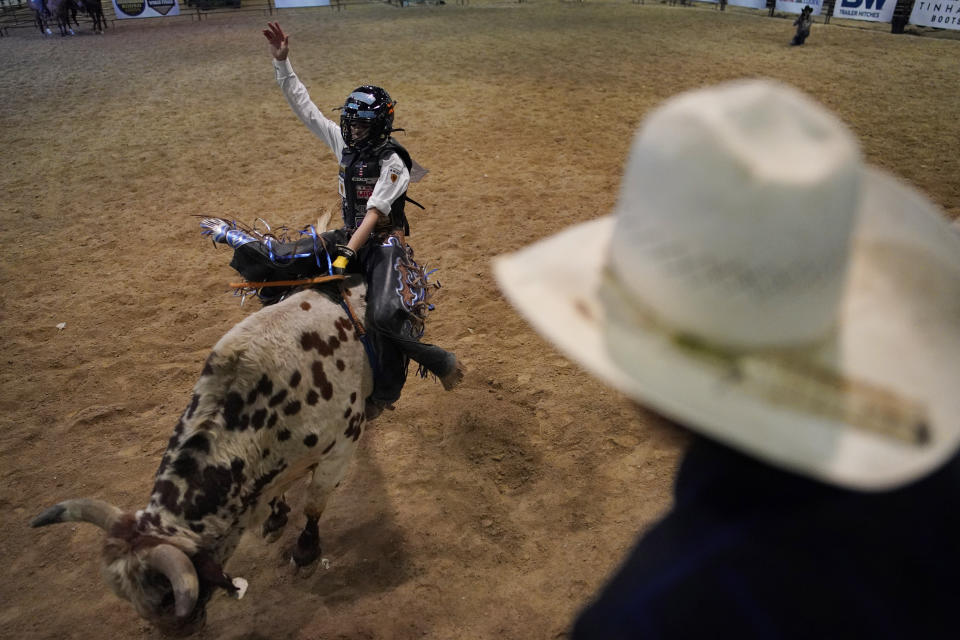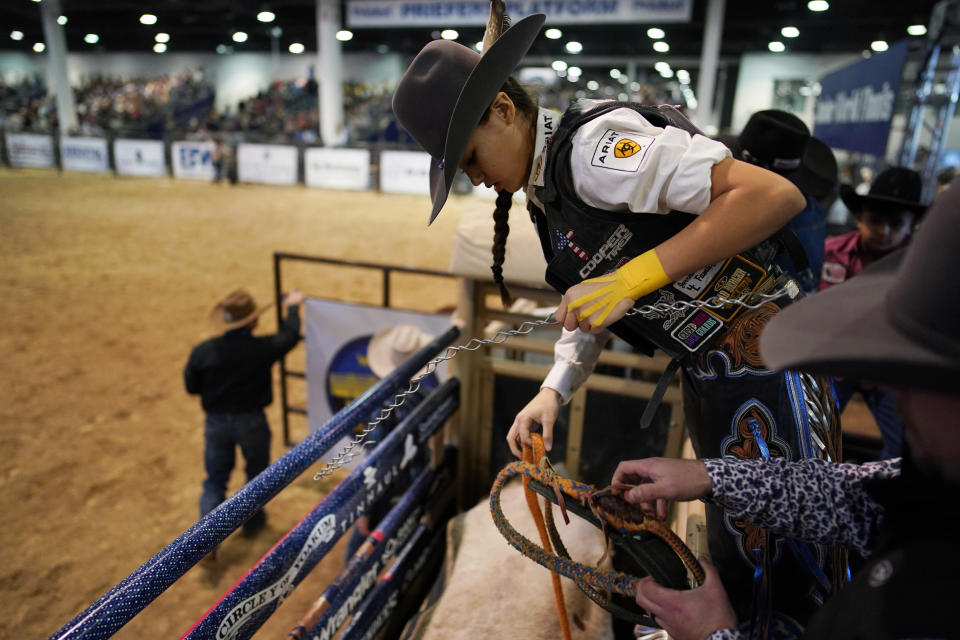Eight seconds on a bucking beast: Here are some of the basics in the sport of bull riding
It's been called the most dangerous eight seconds in sports.
In bull riding, that's how long athletes strive to stay on the bucking animal. It may seem short, but on a bull as big as 2,000 pounds, it can feel much longer.
The sport has a rich and often violent history, reminiscent of a bygone era when cowboys sought to tame the Wild West.
But it’s not a uniquely American sport: Bull riding has its roots in Mexico and is popular in Brazil, Australia and Canada, too.
Here are some of the basics of bull riding.
THE RIDE
Riders grip a rope with one hand and raise the other. If they touch the bull or themselves with their free hand, they get no points. If they let go and fall off before eight seconds, they get no points.
A panel of judges ranks the ride, scoring bull and rider. Each can earn up to 50 points.
There's been one perfect score: Wade Leslie and bull Wolfman Skoal, in 1991 at a Professional Rodeo Cowboy Association event in Washington.
THE HISTORY
In 1600s Mexico, rodeo-like charreadas were staged as competition within festive, cultural events. Riders stayed on the bull until it stopped bucking.
Similar events became popular in the mid-1800s in the southern U.S.
In 1936, at the Boston Garden Rodeo, a group of cowboys staged a strike and formed the Cowboys' Turtle Association, seeking uniform rules and judging, as well as fair prize money, according to the Pro Rodeo Hall of Fame.
That group later became the Rodeo Cowboys Association, then morphed into the Professional Rodeo Cowboys Association, a nonprofit organization that sanctions rodeos across the U.S., Canada and Mexico.
PRCA events include bronc riding, tie-down roping, team roping, steer wrestling, bull riding, steer roping, barrel racing, breakaway roping and bareback riding.
THE LEAGUE
The top bull riding league in the world is Professional Bull Riders. Founded in 1992 by a group of riders seeking to increase the sport's profile, PBR sanctions events in the U.S., Canada, Australia and Brazil. More than 500 riders are members.
Globally, the best riders reach PBR's top level, the Unleash the Beast tour, which gets its name from sponsor Monster beverages. The season runs from November to May.
At 18, riders are eligible for membership and can compete in PBR Touring Pro Division and Pendleton Whisky Velocity Tour events. From there, riders earn points to qualify for Unleash the Beast.
THE TEAMS
PBR's team competition was launched in 2022, with eight teams on the Camping World Team Series: The Austin Gamblers, Kansas City Outlaws, Texas Rattlers, Carolina Cowboys, Arizona Ridge Riders, Missouri Thunder, Florida Freedom and Nashville Stampede.
They compete in an 11-event season, running opposite Unleash The Beast. The team competition runs in conjunction with the Challenger Series for individual riders, also launched in 2022.
The Austin Gamblers have won regular season titles the last two years. The Texas Rattlers won the 2023 team championship event in Las Vegas.
The inaugural teams competition is featured in a documentary series, “The Ride.”
A standalone competition, the Challenger Series, was launched last year, giving riders unaffiliated with teams the chance to compete.
THE RIDERS
The 2023 PBR World Championship winner and Rookie of the Year was Brazilian Rafael Jose de Brito — the first rider to win both honors the same season.
PBR says he earned more than $1.5 million for the season and nearly $1.4 million for the championship and World Finals.
Justin McBride, now a commentator for televised Unleash The Beast tour events, is considered one of the top riders in PBR history. He won world titles in 2005 and 2007, and had 74 career 90-point rides. He was the first rider to reach $5 million in earnings on the tour.
John Crimber, 18, is an Unleash the Beast up-and-comer. The son of Brazilian rider Paulo Crimber, he competed in his first Challenger Series event the day after his birthday and went on to win nine events in 14 tries.
No women have reached the Unleash the Beast level.
THE BULLS
Bucking bulls weigh 1,200 to 2,000 pounds. They're bred specifically for competition, with an average lifespan of 15 years. Most start competing at age 3 to 4, with careers of two to four years, according to PBR, though some get up to 10.
Animal rights activists regularly protest at PBR events. They say bulls are subjected to cross-country travel in cramped trailers and to inhumane practices to get them to buck, such as cattle prods and flank straps.
Riders say bulls are treated like elite athletes, with nutritious food and top-flight veterinary care. PBR bans cattle prods in competition.
PBR says on its website that it's “committed to ensuring the health, safety, welfare, and respect of each bovine athlete" and has "a no tolerance policy for any mistreatment of an animal.”
THE DANGERS
Injuries are common, with estimates of about one every 15 rides. Knee and shoulder injuries are most common. Concussions are also a concern, and PBR started requiring helmets in 2013, though some older athletes accustomed to just hats are grandfathered in.
Deaths are rare but do happen.
In 2021, Amadeu Campos Silva was killed at a PBR event in California; his spur got tangled in a rope and he was caught under the bull. In 2019, Mason Lowe was killed at a Denver PBR event; the bull stomped on his chest and his injuries were fatal despite a protective vest.
___
This story is part of the AP’s Inclusive Journalism Initiative with The Maynard Institute for Journalism Education and The Ida B. Wells Society for Investigative Reporting.
___
More AP sports: https://apnews.com/hub/sports and https://twitter.com/AP_Sports


